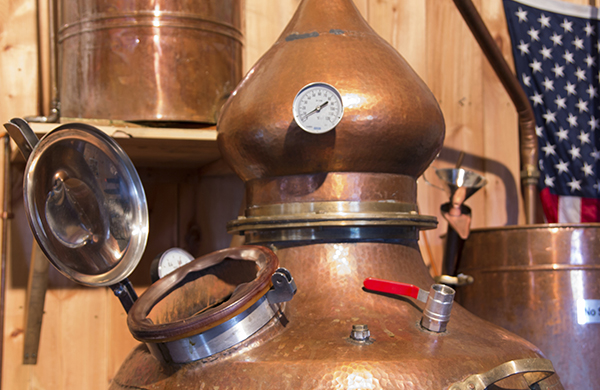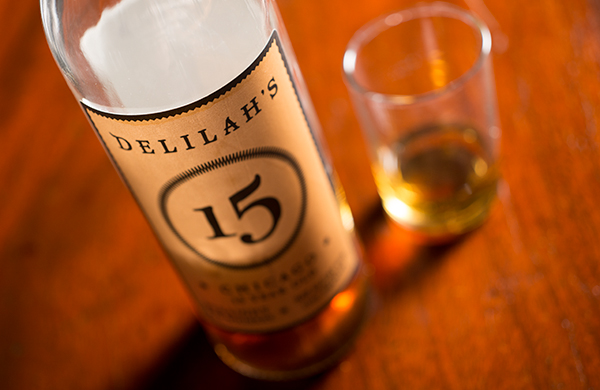
No two people get started on scotch whisky the same way—at least not in Mike Miller’s experience. The Duke of Perth manager has been helping newbies take their first sips of scotch for almost 24 years.
“There are lots of people who take it in little bites,” he said. “Then there are people who just dive right in and love it.”
Even with Miller’s advice to guide you, it’s easy to feel overwhelmed by all the bottles stacked behind his bar. Duke of Perth specializes in single malts, each made with malts from a single distiller, yielding a unique individual flavor. (By contrast, blends such as Dewar’s and Johnnie Walker mix malts from many different distillers to get a standardized taste.)
With more than 100 distillers currently active in Scotland—each of which puts out a multiplicity of different bottlings—that translates to a lot of different options. But that’s only more reason to go beyond familiar names and try something interesting, according to Miller.
“Probably the most common single malt is Glenlivet or Glenfiddich,” he said. “But they’re so ubiquitous, you could probably pick them up at any bar you went to. Why would you come to a place like this?”
Instead, here are Miller’s recommendations of a few lesser-known brands, and his tips on how to try them.

A dry and smoky drink
"I find a lot of other whiskies of the world to be a little more sweet than I like on my palate. Scotch has something that very few other whiskies in the world have, which is a characteristic of peatiness or smokiness. It’s not super evident in all scotch whiskies, but it’s sort of an underlying theme. Scotch leans [more] toward the drier end of the spectrum than the sweeter end, like bourbon or rye."
The first time, try it straight.
"Around here, we like to tell people, if you’re trying something for the first time, skip the rocks or skip the mixers, at least until you familiarize yourself with what that particular malt tastes like on its own. You don’t want to just automatically throw ice in a glass and throw whisky on top of it. Even though that’s how most people perceive scotch as being drunk, on the rocks or with a splash of soda or something."
Then (maybe) add a little water.
"A lot of people believe in the addition of a dash of a real nice neutral water, maybe a spring water or something that doesn’t have a whole lot of mineral flavor in it. [That] helps to open the bouquet up and release some of the more subtle flavors that are in the whisky."
Attend to ABV.
"On the label, it’ll always be identified how much alcohol there is by volume in that whisky. It might be as low as 40% and it might be as much as 55%–60% … That is more alcohol than the human palate really likes to taste. So you do want to, in the case of, say, whisky that’s 60% ABV, add a little water for sure."
Pick your glassware carefully.
"You probably have seen this one particular style of glass designed for whisky tasting; it’s called a Glencairn glass. It looks kind of rounded at the bottom and then focuses up to sort of like a chimney, like an inch and a half [diameter]. That’s real popular. I’m not crazy about that glass. I think that something that helps to focus the nose a little so that you can appreciate what’s coming off of the whisky, like maybe swirl it around a bit and give it a nosing. I think a snifter works great."

Photo courtesy of Flickr user Jean-Francois Pilon
Older whiskies are (usually) mellower...
"A lot of what the whisky ends up tasting like depends on the way it’s matured. It’s always matured a minimum of three years in an oak cask before it can even be called scotch whisky. After that, there is no law saying you must take it to 12 years ... but a lot of people give it more time. Maybe give it a little shot of maturation in an oak cask that was used to age wine of some sort. The traditional reuse casks have been, for years, sherry—sherry oak from Spain. The residual wine that’s still in the pores of the wood actually affects the whisky during its maturation period and translates to adding things like richness and fruitiness.
"Typically, the longer [whisky is] exposed to wood, the mellower it’s going to get, but it’s not always 100% true that the older the better. Many malts seem to have that sweet spot where if they go beyond that, it’s almost too much exposure to wood. But if you take it to like 15 years old or whatever, that’s like perfect. That’s why you’ll see different ages represented from producers."
...but younger whiskies are cheaper.
"If they’re cost-conscious, [a customer] might go for, say, a 10-year-old bottling by Macallan. But if they’re not as worried about the price, and they like this stuff enough that they can afford to spend whatever they want on it, they can go with 25-year-old Macallan. Even though it’s the same malt whisky they started with, the maturation has a lot to do with the end product that’s in the bottle."
Think about what you already drink.
"[When recommending a scotch,] I try to feel people out and see how adventurous they are, maybe quiz them a little about what they’re typically used to drinking. 'What’s your favorite go-to drink? Is it wine or is it beer? Do you drink a spirit? Do you like vodka or are you partial to tequila or gin?'
"If someone says, 'The only thing I can drink when I drink a spirit is a vodka orange juice' ... that’s completely masking the flavor of the alcohol—or the spirit, I should say. (I’m using too many things interchangeably!) If they’re looking for something … that’s as innocuous as possible, then I’m going to go to the gentler, milder whiskies to start.
"But if they say, 'Oh, I like a nice tequila,' or 'I drink a lot of bourbon,' I’ll take them into slightly deeper waters.
"And then there are the people who say, 'Well, just give me whatever you like best.' They’re jumping into the way deep end! I’m probably going to give them something with a lot of peat and smoke because that’s what I like best."
Suggested spirits:
If you want something mild:
"If you’re looking to stay light, a good bet is Glenkinchie, a nice lowland malt, or Dalwhinnie, a nice, light highland malt. Also Cragganmore is one I happen to like. It does have a great deal of stuff going on, but it’s on such a subtle level that it kind of comes to you slowly."
If you're ready for the "way deep end":
"On the more wild, adventurous end of the spectrum are malts like Laphroaig, [which is] from an island called Islay. There’s only eight distilleries on Islay, but they all produce a discernible smoky quality to their whisky."
If you're in-between:
"If we were going to take it to an intermediate level—let’s say that someone had an interest in that sherry maturation style—there’s Macallan for sure. Also a distiller that I like a lot called Aberlour. A great value, I think: for the price, you get a really nice whisky. It’s got that kind of rich fruitiness of a sherry-influenced whisky." (Editor's note: Mike also recommended Balvenie later on in our conversation.)
Get spirited about more bar-related topics:
 |  |  |
| Today’s Moonshiners Are Tomorrow’s Distillers | The Return of Rye: A New Old-Fashioned Whiskey | Japanese Whisky: A Beginners' Guide |











